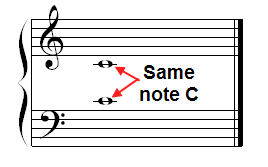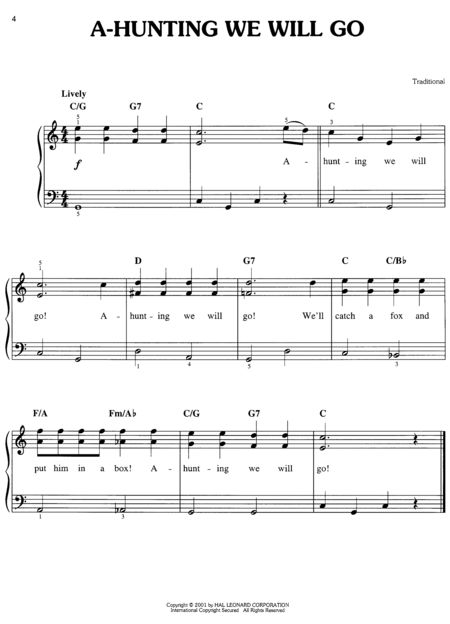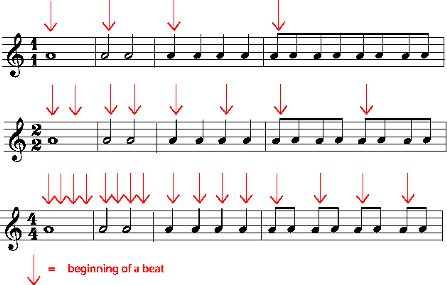Welcome back to my blog! The topic for this post is piano sheet music, and by the end of reading this you will be able to at least understand how to play almost any song that is put in front of you, even though actually trying to play the song may be difficult at this point. After enough practice, however, you will be able play just about anything.
Have you been wondering why the labelled keys in my last post started on C instead of A? This is because piano sheet music is organized in such a way that it separates the keys on a piano at a key called "middle C", which is the fourth C from the left. The sheet music separates the piano keys by having a treble clef and a bass clef, with middle C being somewhat of a no mans land between the two clefs. The two clef system looks like this:
Have you been wondering why the labelled keys in my last post started on C instead of A? This is because piano sheet music is organized in such a way that it separates the keys on a piano at a key called "middle C", which is the fourth C from the left. The sheet music separates the piano keys by having a treble clef and a bass clef, with middle C being somewhat of a no mans land between the two clefs. The two clef system looks like this:
The symbol in the five lines on the top represents the treble clef, and the symbol in the bottom five lines represents the bass clef. The treble clef will show notes that are played to the right of middle C, while the bass clef will show notes that are played to the left of middle C. As you can see from the above image, the two clefs meet at middle C, which is shown twice in the picture, once per clef. The clef system does not take into account the black keys of the piano, so every note you see will be a white note unless it has a sharp or flat symbol next to it. This may be a little confusing right now, but stay with me and you will understand it. Each line represents a different note, and each space between the lines represents a note. The following picture shows which spaces and which lines represent which notes:
Looking at the treble clef, you can see that middle C is in the same spot that is was for the previous picture, and it will always be that way. As you can see, the treble clef may have notes that fall below middle C, and the bass clef may have notes that fall above middle C, but this does not happen often. It would do you well to memorize which note each line and space represents. Now it is time to look at some real music.
Piano music is split up into measures, which are represented by vertical lines on each of the horizontal clef lines. Each measure has a set number of beats, which is determined by the time signature. The following picture is a piece of sheet music that shows measures and time signatures:
Piano music is split up into measures, which are represented by vertical lines on each of the horizontal clef lines. Each measure has a set number of beats, which is determined by the time signature. The following picture is a piece of sheet music that shows measures and time signatures:
In the above picture, all of the vertical lines are measures that help to organize the music. Like I said before, the beats in each measure are determined by the time signature, which is shown right next to the treble and bass clef symbols on the top line. In this case, the time signature is 4/4. The top number of the time signature determines how many beats are in a measure, and the bottom number determines what type of note counts as one beat. So in this case, there are four beats in each measure, and a quarter note counts as one beat. There are many different types of time signatures, such as 3/4, 3/8, 6/8, 2/4, etc. In the case of a 3/8 time signature, there are 3 beats in one measure, and an eighth note counts as one beat. Right now I am assuming that most of you do not know the difference between a quarter note and an eighth note, let alone all of the other symbols that you will need to know. To fix this problem, feel free to click the following button:
That website holds a lot of information, but I think it does a fantastic job of organizing it all and presenting it in an easy to learn way. When it comes to the key signatures, I will teach you a good way to learn them and how to use them in my next post.
Determining what types of notes fit where and what they represent in different time signatures can be confusing, so I will walk you through this helpful piece of sheet music:
Determining what types of notes fit where and what they represent in different time signatures can be confusing, so I will walk you through this helpful piece of sheet music:
The above image shows three different time signatures and how the different types of notes fall into each time signature. On the top line, The time signature is 1/1, so there is one beat in a measure and a whole note counts as one beat. In the second line, there are two beats per measure and a half note counts as one beat. In the third line, there are four beats in a measure and a quarter note counts as one beat. So, each line has the exact same notes and are played in the exact same pattern, so shouldn't all of the lines sound the same? Well, yes and no. You can make each line sound the same by changing the tempo. However, for our case lets say that all three lines have a tempo of 48 on a metronome. If you don't have a metronome, you can click this button:
For simplicity's sake, let's start on the bottom line and then you can use the same methods to practice on the other two lines. On the bottom line, there are four beats per measure, so the metronome needs to click four times before the measure is done. The whole note counts as four beats because the quarter note counts as one beat, so when you play the whole note you need to hold down the key for four clicks. In the next measure, each half note counts as two beats, so you hold down each note for two clicks before moving on to the next measure. Using the same method, one quarter note takes up one click, and one sixteenth note takes up half a click. If you are having trouble, look at the red arrows in the picture. The arrows signify each click of the metronome. Now, using the rules of time signatures and the metronome tempo of 48, play the other two lines. What differs between each of the lines? If you do it correctly, you should find that the middle line is twice as fast as the bottom line, and the top line is twice as fast as the middle line.
Now try to do something a little bit more complex. Using the song "A-Hunting We Will Go" that I placed earlier in this post, draw in your own arrows (one arrow being one beat) and try to play the song. Remember that for this case each measure will have four beats and the quarter note counts as one beat. To help you play the song, first learn the bass clef with your left hand, then the treble clef with your right hand, and then combine the two when you are ready.
At this point you should be able to understand what everything means on even some of the most complicated pieces of music, but I do not expect you to know how to begin to play anything more than the most basic pieces. In my next post I will put you on the right track for playing some more difficult pieces, and I will give you some invaluable advice in being able to skillfully play the piano.
Now try to do something a little bit more complex. Using the song "A-Hunting We Will Go" that I placed earlier in this post, draw in your own arrows (one arrow being one beat) and try to play the song. Remember that for this case each measure will have four beats and the quarter note counts as one beat. To help you play the song, first learn the bass clef with your left hand, then the treble clef with your right hand, and then combine the two when you are ready.
At this point you should be able to understand what everything means on even some of the most complicated pieces of music, but I do not expect you to know how to begin to play anything more than the most basic pieces. In my next post I will put you on the right track for playing some more difficult pieces, and I will give you some invaluable advice in being able to skillfully play the piano.




 RSS Feed
RSS Feed